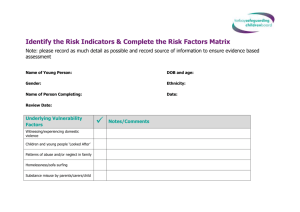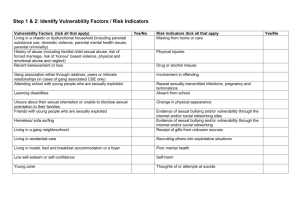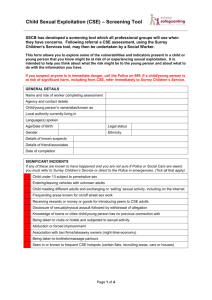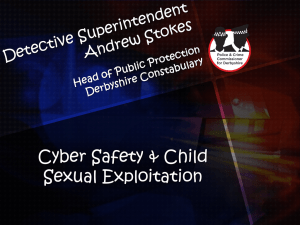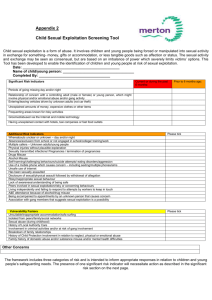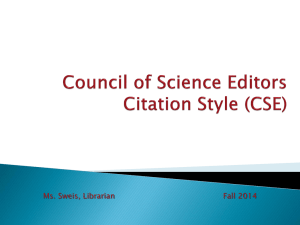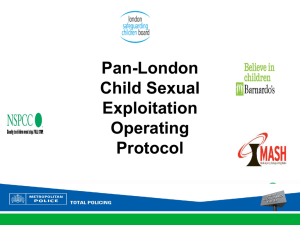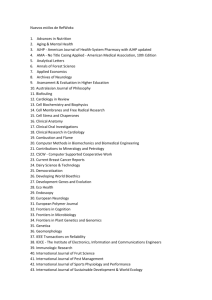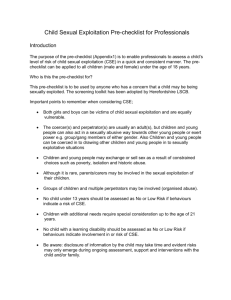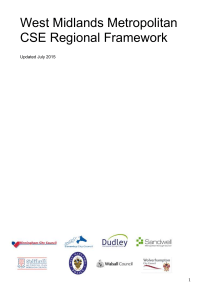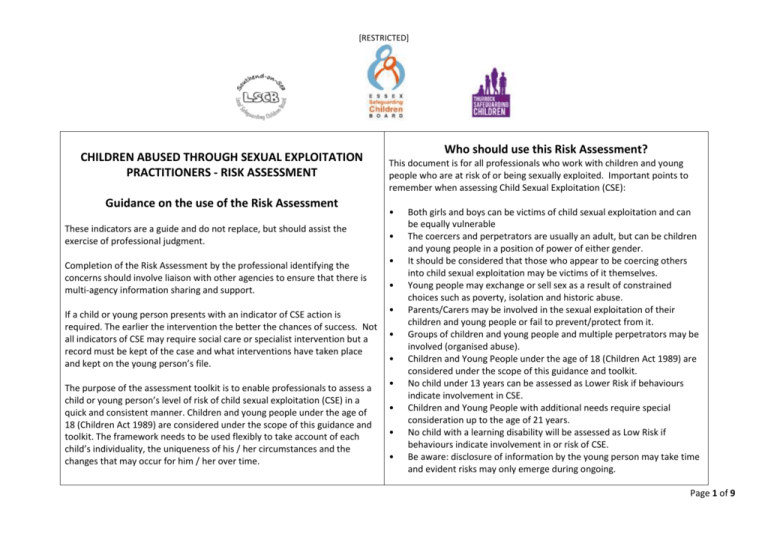
[RESTRICTED]
CHILDREN ABUSED THROUGH SEXUAL EXPLOITATION
PRACTITIONERS - RISK ASSESSMENT
Guidance on the use of the Risk Assessment
These indicators are a guide and do not replace, but should assist the
exercise of professional judgment.
Who should use this Risk Assessment?
This document is for all professionals who work with children and young
people who are at risk of or being sexually exploited. Important points to
remember when assessing Child Sexual Exploitation (CSE):
•
•
Completion of the Risk Assessment by the professional identifying the
concerns should involve liaison with other agencies to ensure that there is
multi-agency information sharing and support.
•
If a child or young person presents with an indicator of CSE action is
required. The earlier the intervention the better the chances of success. Not
all indicators of CSE may require social care or specialist intervention but a
record must be kept of the case and what interventions have taken place
and kept on the young person’s file.
•
The purpose of the assessment toolkit is to enable professionals to assess a
child or young person’s level of risk of child sexual exploitation (CSE) in a
quick and consistent manner. Children and young people under the age of
18 (Children Act 1989) are considered under the scope of this guidance and
toolkit. The framework needs to be used flexibly to take account of each
child’s individuality, the uniqueness of his / her circumstances and the
changes that may occur for him / her over time.
•
•
•
•
•
•
•
Both girls and boys can be victims of child sexual exploitation and can
be equally vulnerable
The coercers and perpetrators are usually an adult, but can be children
and young people in a position of power of either gender.
It should be considered that those who appear to be coercing others
into child sexual exploitation may be victims of it themselves.
Young people may exchange or sell sex as a result of constrained
choices such as poverty, isolation and historic abuse.
Parents/Carers may be involved in the sexual exploitation of their
children and young people or fail to prevent/protect from it.
Groups of children and young people and multiple perpetrators may be
involved (organised abuse).
Children and Young People under the age of 18 (Children Act 1989) are
considered under the scope of this guidance and toolkit.
No child under 13 years can be assessed as Lower Risk if behaviours
indicate involvement in CSE.
Children and Young People with additional needs require special
consideration up to the age of 21 years.
No child with a learning disability will be assessed as Low Risk if
behaviours indicate involvement in or risk of CSE.
Be aware: disclosure of information by the young person may take time
and evident risks may only emerge during ongoing.
Page 1 of 9
[RESTRICTED]
Step 1 – Identify the Risk Indicators
RISK LEVEL
BEHAVIOURS
Y/N
COMMENTS
Truanting from school
Regularly coming home late or
going missing
Overt sexualised dress
Standard risk cases do
not usually meet the
threshold for social care
intervention but should
have a single agency
assessment to identify
whether the threshold is
met for individual or
multi agency
intervention.
One or more indicators
Standard Risk
Sexualised risk taking including on
the Internet
Unaccounted for monies or goods
Associating with unknown adults or
other sexually exploited children or
young people
Reduced contact with
family/friends and other support
networks
Sexually transmitted infections
Experimenting with drugs/alcohol
Poor self-image, eating disorders
some self- harm
Page 2 of 9
[RESTRICTED]
Medium risk
As indicated above, the
indicators are a guide to
assisting the exercise of
professional judgement.
In relation to the medium
level indicators,
professional judgement
should determine
whether the case meets
the threshold for referral
to Children’s Social Care
or other multi agency
procedures. You should
always consult with your
Champion or other
designated Safeguarding
professional
BEHAVIOURS
Any Standard Risk Indicators and one or more Medium Risk Indicators
RISK LEVEL
Y/N
COMMENTS
Getting into cars with unknown
adults
Associating with known CSE adults
Being groomed on the internet
Clipping- (offering to have sex for
money or other payment and then
running before sex takes place)
Disclosure of a physical assault
with no substantiating evidence to
warrant a child protection enquiry,
then refusing to make or
withdrawing a complaint
Being involved in CSE through
being seen in hotspots (i.e.
Houses, recruiting grounds)
Having an older
boyfriend/girlfriend
Non school attendance or
excluded due to behaviour
Staying out overnight with no
explanation
Page 3 of 9
[RESTRICTED]
Breakdown of residential
placements due to behaviour
Unaccounted for money or goods
including mobile phones, drugs
and alcohol
Multiple Sexually Transmitted
Infections
Self-harming that requires medical
treatment
Repeat offending
Gang member or association
Page 4 of 9
[RESTRICTED]
High Risk
All cases should be
referred to Children’s
Social Care. Appropriate
multi agency
intervention will be
undertaken in each case
BEHAVIOURS
Any Low or Medium Risk indicators and one or more High Risk Indicators
RISK LEVEL
Y/N
COMMENTS
Child under 13 engaging in sexual
activity
Pattern of street homelessness and
staying with an adult believed to
be sexually exploiting them
Child under 16 meeting different
adults and exchanging or selling
sexual activity
Removed from known ‘red light’
district by professionals due to
suspected CSE
Being taken to clubs and hotels by
adults and engaging in sexual
activity
Disclosure of serious sexual assault
and then withdrawal of statement
Abduction and forced
imprisonment
Being moved around for sexual
activity
Disappearing from the ‘system’
with no contact or support
Being bought/Sold/trafficked
Multiple miscarriages or
terminations
Page 5 of 9
[RESTRICTED]
Indicators of CSE in conjunction
with chronic alcohol and drug use
Indicators of CSE alongside serious
self-harming
Receiving rewards of money or
goods for recruiting peers into CSE
Step 2 – Identify the child and the assessor
DETAILS OF CHILD AT RISK
Name:
Date Of Birth:
Age:
Place Of Birth:
Home Address:
Telephone Number:
School:
G.P. and Surgery:
Ethnicity:
Gender:
DETAILS OF ASSESSING INDIVIDUAL
Name:
Organisation:
Role / Position:
Address & Telephone:
Date of Assessment:
Secure Email:
(Include direct email as addition if the
secure option is not personal to you).
Page 6 of 9
[RESTRICTED]
Step 3 – Identify additional vulnerability factors
UNDERLYING VULNERABILITY FACTORS
Y/N
COMMENTS
Witnessing/experiencing domestic abuse
Children and young people ‘Looked After’
Patterns of abuse and/ or neglect in family
Homelessness/sofa surfing/
Substance misuse by Parents/Carers/child
Learning disabilities, special needs or mental health issues
Homophobia
Breaks in adult relationships
Death, loss or illness of a significant person in the child’s life
Financially unsupported
Some form of family conflict
Lack of love and security
Adult soliciting (prostitution)
Migrant/refugee/asylum seeker
Page 7 of 9
[RESTRICTED]
Step 4 – Provide a free text description of concerns
DETAILS OF CASE / INCIDENT / INTELLIGENCE
(Please include source of information, names, nicknames, ages, descriptions, vehicle details, addresses, activities, locations, events seen or reported).
Step 5 – Record the other professionals involved
DETAILS OF AGENCY INVOLVEMENT
(either involved in the case or with whom this information has been shared with).
Name
Agency and Address
Telephone Number
Page 8 of 9
[RESTRICTED]
Step 6 – What to do next – CSE Risk Assessment Flowchart
Practitioners CSE Risk Assessment Toolkit completed
Is there identified risk of significant harm?
Yes
No
Discuss with CSE Champion/Safeguarding lead
Follow SET Procedures:
Make referral to IRT
Review assessment of risk of significant harm?
Yes
Contact police
No
Record concerns in line with agency record keeping policy
Share relevant information with appropriate agencies referring to your agency information governance policy regarding consent.
Consider what information can be shared Police CSE Triage Team – CSETT@essex.pnn.police.uk
Identify support network of professionals for child/young person and family in partnership with child/young person and family,
including option of social care early intervention team
Refer when appropriate to local missing / CSE forum: Thurrock – Missing Children Panels, Southend – CSE & Missing group, Essex –
Vulnerable Children’s Partnership Group.
Page 9 of 9

